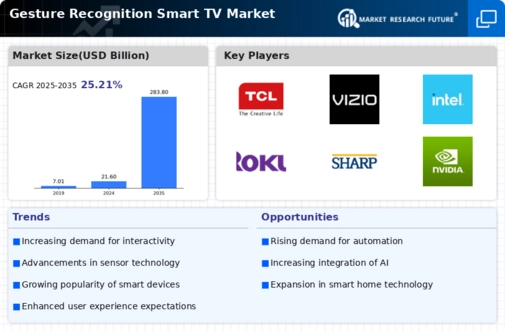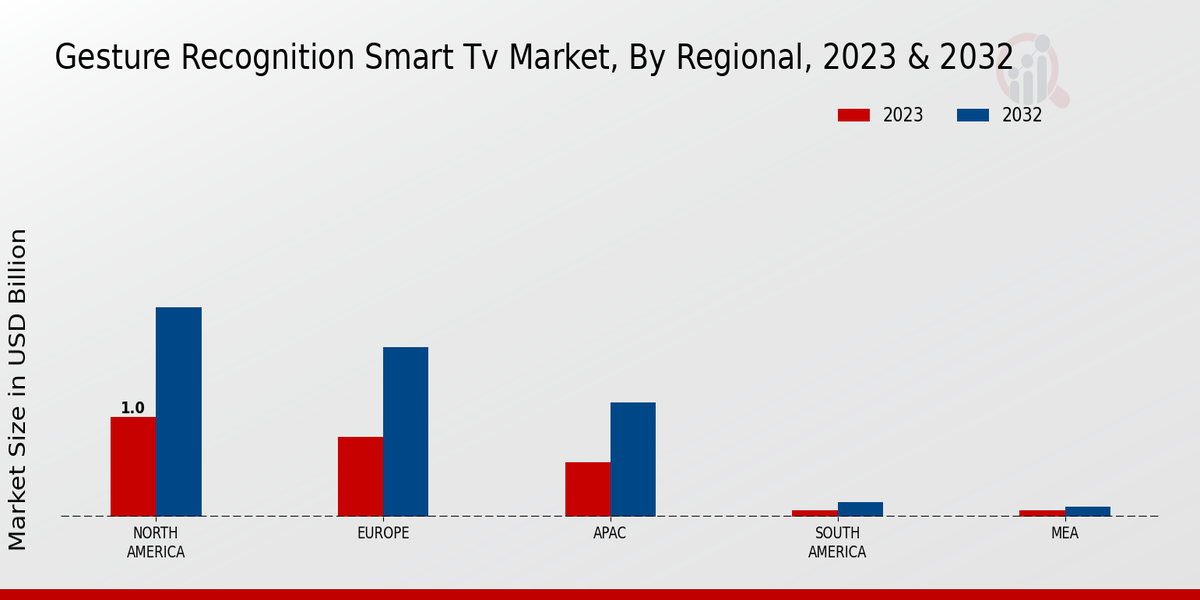Market Growth Projections
Growing Popularity of Interactive Entertainment
The Global Gesture Recognition Smart TV Market Industry is benefiting from the growing popularity of interactive entertainment. As consumers seek more engaging viewing experiences, gesture recognition technology offers a novel way to interact with content. This shift towards interactive platforms, including gaming and virtual reality, aligns with the increasing integration of gesture controls in smart TVs. The market's expansion from 21.6 USD Billion in 2024 to an estimated 283.8 USD Billion by 2035 reflects this trend. The anticipated CAGR of 26.39% from 2025 to 2035 indicates that as interactive entertainment continues to evolve, gesture recognition will play a crucial role in shaping the future of smart TV experiences.
Rising Consumer Demand for Smart Home Integration
The Global Gesture Recognition Smart TV Market Industry is witnessing a surge in consumer demand for smart home integration. As households increasingly adopt smart devices, the desire for seamless interaction among these devices grows. Gesture recognition technology allows users to control their smart TVs and other connected devices with simple hand movements, enhancing convenience and user engagement. This trend is supported by the projected market growth from 21.6 USD Billion in 2024 to an estimated 283.8 USD Billion by 2035. The anticipated compound annual growth rate of 26.39% from 2025 to 2035 indicates a robust market trajectory driven by consumer preferences for integrated smart home ecosystems.
Technological Advancements in Gesture Recognition
The Global Gesture Recognition Smart TV Market Industry is experiencing rapid technological advancements that enhance user experience. Innovations in computer vision and machine learning algorithms enable more accurate gesture detection, allowing users to navigate interfaces seamlessly. For instance, the integration of depth sensors and infrared cameras improves the precision of gesture recognition, making it more responsive to user commands. As a result, the market is projected to reach 21.6 USD Billion in 2024, reflecting a growing consumer preference for intuitive control systems. This trend suggests that as technology continues to evolve, the demand for gesture recognition capabilities in smart TVs will likely increase significantly.
Enhanced User Experience and Accessibility Features
The Global Gesture Recognition Smart TV Market Industry is increasingly focused on enhancing user experience and accessibility features. Gesture recognition technology provides an intuitive interface that caters to diverse user needs, including those with physical disabilities. By enabling users to control their TVs through gestures, manufacturers are making entertainment more accessible to a broader audience. This focus on inclusivity is likely to drive market growth, as companies recognize the importance of catering to all consumers. The projected growth from 21.6 USD Billion in 2024 to 283.8 USD Billion by 2035 underscores the potential for gesture recognition to transform user interactions with smart TVs.
Market Growth Projections and Investment Opportunities
The Global Gesture Recognition Smart TV Market Industry is poised for substantial growth, presenting numerous investment opportunities. With the market projected to expand from 21.6 USD Billion in 2024 to 283.8 USD Billion by 2035, stakeholders are increasingly interested in developing innovative gesture recognition solutions. The anticipated CAGR of 26.39% from 2025 to 2035 suggests a robust demand for advanced technologies that enhance user interaction. Investors and companies are likely to focus on research and development to create cutting-edge products that meet evolving consumer expectations. This growth trajectory indicates a vibrant market landscape, ripe for innovation and investment.






















